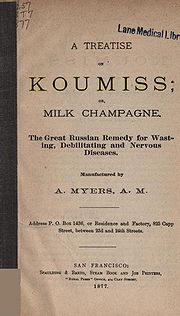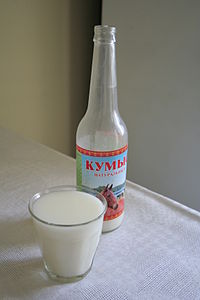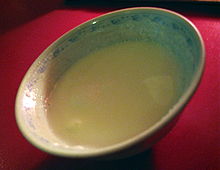- Kumis
-
Kumis, also spelled kumiss or koumiss in English (or kumys, see other transliterations and cognate words below under terminology and etymology) is a fermented dairy product traditionally made from mare's milk. The drink remains important to the peoples of the Central Asian steppes, of Turkic and Mongol origin: Bashkirs, Kazakhs, Kyrgyz, Yakuts, Mongols and Kalmyks.[1] It was also consumed by Baltic, Hungarian tribes.[2]
Kumis is a dairy product similar to kefir, but is produced from a liquid starter culture, in contrast to the solid kefir "grains". Because mare's milk contains more sugars than the cow's or goat's milk fermented into kefir, kumis has a higher, though still mild, alcohol content.
Even in the areas of the world where kumis is popular today, mare's milk remains a very limited commodity. Industrial-scale production of kumis therefore generally uses cow's milk, which is richer in fat and protein but lower in lactose than the milk from a horse. Before fermentation, the cow's milk is fortified in one of several ways. Sucrose may be added, to allow a comparable fermentation. Another technique adds modified whey in order to better approximate the composition of mare's milk.[3]
Contents
Terminology and etymology
Kumis is also transliterated kumiss, kumiz, koumiss, kymys, kymyz, kumisz, kymyz, or qymyz (Kazakh: қымыз, [qəmə́z]; Turkish: kımız; Tatar: кымыз; Kyrgyz: кымыз, [qɯmɯ́z]; Bashkir: ҡымыҙ qımıź [qɯmɯð]; Yakut: кымыс; kymys; Tuvan: хымыс; Uzbek: qimiz, [qɨmɨz]). The Russian word (Russian: кумыс, [kʊmɨs]) comes from the Turkic word qımız.[4] The word kumis is thought to derive from the name of the Kumyks, one of many Turkic peoples.[5]
In Mongolian, the drink is called airag (Mongolian: айраг, [ˈai̯rəg]) or, in some areas, tsegee.[6] William of Rubruck in his travels calls the drink cosmos and describes its preparation among the Tartars
Production of mare's milk
A 1982 source reported that 230,000 horses were kept in the USSR specifically for producing milk to make into kumis.[7]
 A mare being milked in Suusamyr valley, Kyrgyzstan.
A mare being milked in Suusamyr valley, Kyrgyzstan.
Rinchingiin Indra, writing about Mongolian dairying, says "it takes considerable skill to milk a mare" and describes the technique: the milker kneels on one knee, with a pail propped on the other, steadied by a string tied to an arm. One arm is wrapped behind the mare's rear leg and the other in front. A foal starts the milk flow and is pulled away by another person, but left touching the mare's side during the entire process.[8]
In Mongolia, the milking season for horses traditionally runs between mid-June and early October. During one season, a mare produces approximately 1,000 to 1,200 kilograms of milk, of which about half is left to the foals.[9]
Nutritional properties of mare's milk
During fermentation, the lactose in mare's milk is converted into lactic acid, ethanol and carbon dioxide, and the milk becomes an accessible source of nutrition for people who are lactose intolerant.[10]
Before fermentation, mare's milk has almost 40% more lactose than cow's milk.[11] According to one modern source, "unfermented mare's milk is generally not drunk", because it is a strong laxative.[1] Varro's On Agriculture, from the 1st century BC, also mentions this: "as a laxative the best is mare's milk, then donkey's milk, cow's milk, and finally goat's milk...";[12] drinking six ounces (190 ml) a day would be enough to give a lactose-intolerant person severe intestinal symptoms.
Production of kumis
Kumis is made by fermenting raw unpasteurized mare's milk over the course of hours or days, often while stirring or churning. (The physical agitation has similarities to making butter). During the fermentation, Lactobacilli bacteria acidify the milk, and yeasts turn it into a carbonated and mildly alcoholic drink.
Traditionally, this fermentation took place in a horse-hide container, which might be left on the top of the yurt and turned over on occasion, or strapped to the saddle and joggled around over the course of a day's riding. Today, a wooden vat or plastic barrel may be used in place of the leather container.[13]
Other accounts from some cities in northern or western China have it that the skin, partially filled with mares' milk, is hung at the door of each home during the season for making such beverages, and passersby, who are familiar with the practice, give each such skin a good punch as they walk by, agitating the contents so that they would turn into kumis rather than coagulate and spoil.
In modern controlled production, the initial fermentation takes two to five hours at a temperature of around 27 °C (81 °F); this may be followed by a cooler aging period.[14] The finished product contains between 0.7 and 2.5% alcohol.[15]
Kumis itself has a very low level of alcohol, comparable to small beer, the common drink of medieval Europe that also avoided the consumption of potentially contaminated water. Kumis can, however, be strengthened through freeze distillation, a technique Central Asian nomads are reported to have employed.[16] It can also be distilled into the spirit known as araka or arkhi.[17]
History
Kumis is an ancient beverage. Herodotus, in his 5th century BC Histories, describes the Scythians' processing of mare's milk:
The milk thus obtained is poured into deep wooden casks, about which the blind slaves are placed, and then the milk is stirred round. That which rises to the top is drawn off, and considered the best part; the under portion is of less account.[18]
It is widely believed that this is a description of ancient kumis making,[5] and it matches up well enough with later accounts, such as this one given by 13th-century traveller William of Rubruck:
This cosmos, which is mare's milk, is made in this wise. [...] When they have got together a great quantity of milk, which is as sweet as cow's as long as it is fresh, they pour it into a big skin or bottle, and they set to churning it with a stick [...] and when they have beaten it sharply it begins to boil up like new wine and to sour or ferment, and they continue to churn it until they have extracted the butter. Then they taste it, and when it is mildly pungent, they drink it. It is pungent on the tongue like rapé wine when drunk, and when a man has finished drinking, it leaves a taste of milk of almonds on the tongue, and it makes the inner man most joyful and also intoxicates weak heads, and greatly provokes urine.[19]
Health
 In the West, Kumis has been touted for its health benefits, as in this 1877 book also naming it "Milk Champagne".
In the West, Kumis has been touted for its health benefits, as in this 1877 book also naming it "Milk Champagne".
Toward the end of the 19th century, kumis had a strong enough reputation as a cure-all to support a small industry of "kumis cure" resorts, mostly in southeastern Russia, where patients were "furnished with suitable light and varied amusement" during their treatment, which consisted of drinking large quantities of kumis.[20] W. Gilman Thompson's 1906 Practical Diatetics reports that kumis has been cited as beneficial for a range of chronic diseases, including tuberculosis, bronchitis, catarrh, and anemia. Gilman also says that a large part of the credit for the successes of the "kumis cure" is due not to the beverage, but to favorable summer climates at the resorts.[21] Among notables to try the kumis cure were writers Leo Tolstoy and Anton Chekhov. Chekhov, long-suffering from tuberculosis, checked into a kumis cure resort in 1901. Drinking four bottles a day for two weeks, he gained 12 pounds but no cure.[22]
Consumption
Strictly speaking, kumis is in its own category of alcoholic drinks because it is made neither from fruit nor from grain. Technically, it is closer to wine than to beer because the fermentation occurs directly from sugars, as in wine (usually from fruit), as opposed to from starches (usually from grain) that had been first worted to be converted to sugars, as in beer. But in terms of experience and traditional manner of consumption it is much more comparable to beer. It is even milder in alcoholic content than beer and is usually consumed cold. It is arguably the region’s beer equivalent.
Kumis is very light in body compared to most dairy drinks. It has a unique, slightly sour flavor with a bite from the mild alcoholic content. The exact flavor is greatly variable between different producers.
As indicated above, kumis is usually served cold or chilled. Traditionally it is sipped out of small, handle-less, bowl-shaped cups or saucers, called piyala. The serving of it is an essential part of Kyrgyz hospitality on the yaylak or high pasture, where they keep their herds of animals (horse, cattle, and sheep) during the summer phase of transhumance.
One custom that may be disturbing to the visitor's notions of hygiene is that of pouring the dregs of each cup back into the kumis storage container. That way, none is wasted, and the hostess assures herself that there will be enough for future visitors.
Cultural role
The capital of Kyrgyzstan, Bishkek, is named after the paddle used to churn the fermenting milk, showing the importance of the drink in the national culture.
In A Confession, Leo Tolstoy, a famous Russian writer, spoke of running away from his troubled life by drinking kumis.[23]
See also
References and notes
- ^ a b Zeder, Melinda A. ed. (2006). Documenting Domestication: New Genetic and Archaeological Paradigms. University of California Press. pp. .264. ISBN 0-520-24638-1.
- ^ 2005-2011 Food and Culture Resources. | http://www.food-links.com/countries/hungary/foods-commonly-used-hungary.php
- ^ Law p. 121.
- ^ Dictionary.com Unabridged - Kumiss entry
- ^ a b Kurmann, Joseph A. et al. (1992). Encyclopedia of Fermented Fresh Milk Products. Springer. pp. 174. ISBN 0-442-00869-4.
- ^ Ayrag - Fermented Mare's Milk - Mongolian Beverage
- ^ Steinkraus, Keith H. ed (1995). Handbook of Indigenous Fermented Foods. Marcel Dekker. pp. 304. ISBN 0-8247-9352-8.
- ^ Indra, Rinchingiin (2003). "Mongolian Dairy Products". In Dendev Badarch, Raymond A Zilinskas. Mongolia Today: Science, Culture, Environment and Development. Routlege. pp. 74. ISBN 0-7007-1598-3.
- ^ Indra p. 73.
- ^ See also Nutritional Adaptation by O'Neil, Dennis, Palomar College: "In the Indian subcontinent and much of Central and Western Asia, dairy products are consumed frequently but usually only after bacteria (lactobacilli) have broken down the lactose. After this has occurred, milk becomes yoghurt or kumis, both of which are relatively easily digested even by people who produce little lactase."
- ^ By weight, cow's milk averages 4.8% lactose and mare's 6.3%. McGee p. 13.
- ^ Humphrey, John W. Greek and Roman Technology: A Sourcebook. Routledge. pp. 131. ISBN 0-415-06137-7.
- ^ Mischler and Sosorbaram (2005-2006). Ayrag. Mongolian Food Info. Retrieved 11 September 2006.
- ^ McGee, Harold (2004). On Food and Cooking (Revised Edition). Scribner. pp. 46. ISBN 0-684-80001-2.
- ^ Law, B A ed. (1997). Microbiology and Biochemistry of Cheese and Fermented Milk. Springer. pp. 120. ISBN 0-7514-0346-6.
- ^ McGee p. 761
- ^ Mongol Arkhi - Milk Liquor - Beverage from Mongolia
- ^ Histories, book four. Translation by George Rawlinson; available online at The Internet Classics Archive.
- ^ Rockhill, William, translator (1900). The Journey of William of Rubruck to the Eastern Parts of the World, 1253-55. p. 67. London: Hakluyt Society.
- ^ Thompson, William Gilman (1906). Practical Dietetics. D. Appleton. pp. 84.
- ^ Gilman p. 81 and 84.
- ^ Boyd, William (2004). Anton Chekhov: An A-Z. A Penguin Classics feature. Retrieved July 12, 2006.
- ^ "Tolstoy, Leo - Confession". http://www.classicallibrary.org/tolstoy/confession/3.htm.; Transliterated as "kumys".
Alcohol and health General 
Conditions digestive systemcardiovascular systemDisorders Alcohol abuse · Alcohol dependence · Alcohol flush reaction · Alcohol induced mood disorders · Alcohol intoxication · Alcoholic psychoses · Alcohol withdrawal syndrome / Post-acute-withdrawal syndrome (PAWS) · Alcoholism (alcohol addiction) · Fetal alcohol syndrome (FAS) / Fetal alcohol spectrum disorder (FASD)Interactions Alcohol tolerance · Alcohol myopia · Aging · Breast cancer · Cancer · Family systems · Sex · Sleep · Weight · Short-term effects of alcohol/Long-term effects of alcohol · Neonatal abstinence syndrome (NAS)Movements Categories:- Fermented foods
- Fermented beverages
- Dairy products
- Horse products
- Central Asian cuisine
- Mongolian cuisine
- Kazakhstani cuisine
- Turkic loanwords
- Yoghurts
Wikimedia Foundation. 2010.





